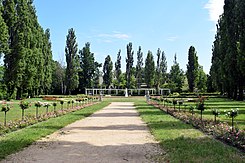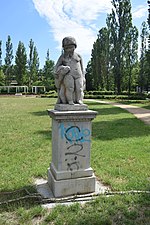Bernkastler Platz
| Bernkastler Platz | |
|---|---|
| Park in Berlin | |

|
|
| Bernkastler Platz, view from the direction of the cheese bell along the main path flanked by roses with statuettes to the fountain and the pergola | |
| Basic data | |
| place | Berlin |
| District | Lankwitz |
| Created | 1910-1914 |
| Newly designed | 1975-1989 |
| Surrounding streets |
Leonorenstrasse , Bernkastler Strasse , Bruchwitzstrasse , Alsheimer Strasse |
| Buildings | Cheese bell |
| use | |
| User groups | Pedestrians , leisure |
The Bernkastler Platz ( colloquially : rose garden ) is a protected green area in the Berlin district of Lankwitz . The park -like city space is a testimony of the garden art of the Wilhelmine era , a cultural monument of Berlin.
location
The trapezoidal square is located in the so-called Weinviertel of Lankwitz on Leonorenstraße between the embankment of the Anhalter Vorortbahn and Bernkastler Straße. In the east the square borders on Bruchwitzstrasse.
The former multi-storey car park, which is colloquially known as the cheese bell , and a forecourt is located on Leonorenstrasse . Opposite are the town hall and the S-Bahn station ( line S25 ). There are several bus routes in Leonorenstraße with stops in the immediate vicinity of the square.
history
Under Rudolf Beyendorff as the first mayor of the community of Lankwitz, which was then part of the Teltow district (a district of Berlin from 1920), the village of Lankwitz was developed from 1908–1914 into the garden city of Lankwitz , a modern community as a suburb of Berlin for the wealthy bourgeoisie from Berlin.
The first construction of the town square on what was then Viktoriastraße (since 1937: Leonorenstraße) took place as place A – B of Straße 8 in 1910 with expansion by 1914 by the municipality of Lankwitz as client . On October 24, 1912, the square and the former street 8 of the development plan were dedicated to the Rhineland-Palatinate town of Bernkastel-Kues .
The system shielded the adjoining, multi-storey apartment buildings, whose facades were modeled on English garden cities, from the embankment. In a publication by the Lankwitz municipal administration from 1914 on Bernkastler Platz you can read:
“In the immediate vicinity of the Rathausplatz, facing east, forming the entrance to the Weinviertel, is the Bernkastler Platz with the multi-storey car park on Viktoriastraße. The Bernkastler Platz, developed both architecturally and horticultural by the surrounding buildings, with its wide green areas, its picturesquely interspersed flower beds, the beautifully manicured gravel paths and the large water basin on the east side, framed in the background by a flower-adorned pergola arcade, offers such a thing graceful sight that he always finds undivided recognition. Fortunately, the character of the jewelery area is combined with that of the recreation area and it is a pleasure to see how the young people, unconcerned about the rising water column of the fountain, float their boats here and enjoy the goldfish playing lively in the sun how the little ones happily dig in the sand and the older ones do their various sports. "
On the night of August 23-24, 1943, which went down in history as the Lankwitz bombing night , Lankwitz was (mistakenly) bombed by the Royal Air Force . Large parts of Lankwitz were completely destroyed, including all the residential buildings in the vicinity of Bernkastler Platz and the nearby station building, which was built in 1895. The opposite town hall was badly damaged, as well as the dome of the multi-storey car park (cheese bell) was destroyed.
The reconstruction of the historic green area began in 1975. For this purpose, it was almost only possible to use old postcards and photos, which made the reconstruction particularly difficult according to the responsible monument protection authority. The water basin with fountain had to be demolished and rebuilt due to the completely desolate building structure. Various original design elements such as the beech hedges surrounding the square, the pergola , rose borders and pavement ornaments with rose rondelles have been restored. Before the reconstruction, the extended main path leading to the water basin was shortened in accordance with the original layout and the end marked with two reconstructed statuettes . The reconstructed square was opened to the public in 1988 on the occasion of the Lankwitz 750th anniversary celebration and protected as a garden monument.
The square was named Monument of the Month January 2017 by the Steglitz-Zehlendorf district.
Gardens and multi-storey car park
general description
The Bernkastler Platz is one of the few remaining examples of inner-city garden art and belongs to the Berlin Schmuckplatz era. With a fountain , pergola and putti on pedestals , the around 18,000 m² green area corresponds to the representational desire of the Wilhelmine era (1890–1918). As a testimony to this garden art, Bernkastler Platz was entered in the Berlin list of monuments as a garden monument in the interest of its preservation for the general public . The garden architect is not known, the builder was the then Lankwitz community from 1910–1914.
The square is strictly geometrically designed in the form of an isosceles trapezoid (leg length 240 meters, base length 80 meters). It is aligned with an associated multi-storey car park (colloquially known as the cheese bell ) and forecourt on the narrowest side, which once formed the entrance gate to the park with a gate on the ground floor from Leonorenstrasse and established the main path in the central axis. The pseudo perspective effect is reinforced by two rows of pyramid poplars , which stand parallel to the long sides along the railway embankment and Bernkastler Straße and flank the surrounding path.
The end of the main path is marked by two statuettes , reconstructed from historical photos, depicting children with animals. In the central axis there is a water basin with a single jet fountain. The lawn in front of the water basin is enclosed, like the basin, by arched paths. A wooden pergola with benches is attached to the pool.
The protected green area has a playground in the eastern area (corner of Bruchwitzstrasse and Bernkastler Strasse). The historical, symmetrically laid out ornamental beds with lush flowering flowers no longer exist.
Water basin and pergola
In the eastern part of the square there is an oval brick basin with a seating edge and a single-jet fountain in the middle. The original water basin with central fountain, built around 1910, was demolished as part of the renovation of the entire complex and rebuilt in 1988 in a five-month construction period. The fountain, which used to be supplied with service water , was given a circulation pump. The length of the water basin is 26 meters, the width 22 meters and the brick wall is 40 centimeters high.
The wide northeast side is framed by a curved white wooden pergola with resting places above the water basin . The pergola was recreated on the basis of photographs of the historical original as part of the reconstruction.
Cheese bell

The designed by the former Commissioner of City Planning Lankwitzer community 1913-1914 Fritz Freymüller established as a park house building, colloquially Kaseglocke is called, is located in the central axis on the narrow side of the park to the west. Originally, a gate passage on the ground floor from Leonorenstrasse formed the entrance to the park-like town square. The multi-storey car park, also known as a pavilion , formed an ensemble of buildings with the richly decorated town hall (built 1910–1911) and the formerly no less magnificent station building (completed in 1895, completely destroyed in 1943).
The building was built as a rental apartment building with six residential units. During the bombing night in Lankwitz in August 1943, the dome was destroyed as a result of an incendiary bomb , and residents were able to prevent it from being completely burned down.
After the Second World War, the Käseglocke served as a residential building for teachers at the Lankwitz grammar school, which was called the Beethoven High School from 1954 , until it was converted into a children's and youth recreational facility in the Steglitz district in 1958 . Until May 2004, the building was the seat of the district youth home Theodor Fontane . Since June 2004 the establishment under the name is Kaseglocke in free sponsorship of the club game & Action e. V. continued. The focus of the work of the children, youth and family meeting is open door work , the offers are open to everyone and without registration; there are u. a. a breakfast café, a lunch table, a play area, a youth room with table football and billiards as well as events such as the flea market, which sometimes take place in the rose garden.
The building at Leonorenstraße 65 is listed as a monument car park in the Berlin monument list. From the park are well centered over the entrance archway and former head of a woman right and left above the windows, two children's heads as a relief to see that will represent the family of architects.
See also
literature
- Klaus Konrad Weber: Berlin and its buildings . Part 11: Gardening . Edited by the Berlin Architects and Engineers Association . Michael Imhof Verlag, Petersberg 1972, ISBN 3-433-00587-7 .
Web links
- Bernkastler Platz. In: Street name lexicon of the Luisenstädtischer Bildungsverein (near Kaupert )
- Entry in the Berlin State Monument List
- Ludwig Schlottke: Bernkastler Platz on the website of the Steglitz-Zehlendorf district office
- Monument of the month January 2017: Bernkastler Platz . District Office Steglitz-Zehlendorf (PDF; 1.9 MB).
- Karla Rabe: Bernkasteler Platz was created for the bourgeoisie . In: Berliner Woche , January 21, 2017.
- Uwe Schmohl (Lower Monument Protection Authority Steglitz-Zehlendorf): Bernkastler Platz in Lankwitz is Monument of the Month for January . In: District Center Steglitz e. V. (Ed.): Stadtrandnachrichten , January 5, 2017.
Individual evidence
- ↑ Karla Rabe: Bernkasteler Platz was created for the bourgeoisie . In: Berliner Woche (online), January 21, 2017, accessed on March 25, 2017.
- ↑ a b StreetsABC: L for Leonorenstraße: Bernkastler Platz and Käseglocke . In: District Center Steglitz e. V. (Ed.): Standtrandnachrichten , August 19, 2013, accessed on January 31, 2017.
- ↑ Municipal administration Berlin-Lankwitz (ed.): Gartenstadt Berlin-Lankwitz: Description of the place and advice on choosing a place to live and rest . W. Büxenstein printing works, Berlin SW 1914, pp. 12-13. Quoted from: Reprint 1987 of the 1914 edition, Arbeitskreis Historisches Lankwitz, pp. 12-13.
- ↑ See Martin Middlebrook: The Berlin raids. RAF bomber command winter 1943-44. Viking, London 1988, ISBN 978-0-670-80697-3 ( English ).
- ↑ Wolfgang Friese: Why did Lankwitz have to die? In: Heimatverein Steglitz e. V. (Ed.): Steglitzer Heimat , 53rd vol., No. 1, Berlin 2008, pp. 31–37.
- ^ Paul Hiller: Chronik Lankwitz (= preprint . Vol. 5/6). Word & Image Specials, Berlin 1989, ISBN 3-926578-19-X .
- ↑ Large fountain (single jet) Bernkastler Platz on the website of the Senate Department for Urban Development and Housing, accessed on January 31, 2017.
- ↑ Ensemble Rathaus Lankwitz with Lankwitz S-Bahn station and parking garage in the Berlin State Monument List, accessed on January 31, 2017.
- ↑ a b History of the Cheese Bell . Website of the Spiel & Action e. V., accessed on January 31, 2017.
- ↑ Parking garage in the Berlin State Monument List, accessed on January 31, 2017.
Coordinates: 52 ° 26 ′ 23.5 " N , 13 ° 20 ′ 41.3" E

